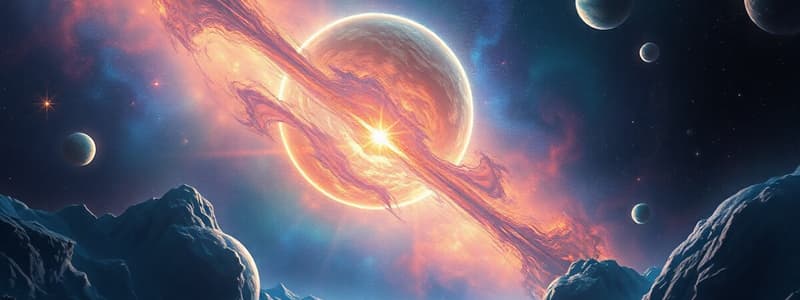Podcast
Questions and Answers
The Earth's atmosphere extends infinitely far from the Earth, encompassing the moon.
The Earth's atmosphere extends infinitely far from the Earth, encompassing the moon.
False (B)
The Earth's orbit around the sun is perfectly circular.
The Earth's orbit around the sun is perfectly circular.
False (B)
A planet generates its own light and heat through nuclear fusion.
A planet generates its own light and heat through nuclear fusion.
False (B)
Telescopes are primarily used to observe nearby objects within the same room, enhancing their visibility.
Telescopes are primarily used to observe nearby objects within the same room, enhancing their visibility.
Constellations are fixed patterns of stars that appear to move relative to each other over short periods due to stellar drift.
Constellations are fixed patterns of stars that appear to move relative to each other over short periods due to stellar drift.
An astronaut must possess a background solely in astrophysics to travel in outer space.
An astronaut must possess a background solely in astrophysics to travel in outer space.
The United States has never successfully launched a rocket into space.
The United States has never successfully launched a rocket into space.
Phenomena and objects associated with the moon are referred to as solar.
Phenomena and objects associated with the moon are referred to as solar.
A bicycle manufactured five years ago by a now-defunct company would typically be considered an ancient artifact.
A bicycle manufactured five years ago by a now-defunct company would typically be considered an ancient artifact.
When viewed from above, an object rotating counterclockwise turns in the same direction in which the hands of a clock move.
When viewed from above, an object rotating counterclockwise turns in the same direction in which the hands of a clock move.
Flashcards
Orbit
Orbit
The path an object takes around another object in space.
Constellations
Constellations
Groups of stars that form recognizable patterns in the night sky.
Astronaut
Astronaut
A person who travels into outer space.
Launch
Launch
Signup and view all the flashcards
Solar
Solar
Signup and view all the flashcards
Ancient
Ancient
Signup and view all the flashcards
Counterclockwise
Counterclockwise
Signup and view all the flashcards
Determined
Determined
Signup and view all the flashcards
Inner
Inner
Signup and view all the flashcards
Major
Major
Signup and view all the flashcards
Study Notes
- The atmosphere is not the part that is far away from Earth and contains the moon.
- Earth travels in an orbit around the sun.
- A planet is not a small object that provides its own light and heat.
- Scientists do not use telescopes to look at objects in the same room as them.
- Constellations, or groups of stars that look like pictures, can be seen in the sky on a clear night
- An astronaut is someone who travels in outer space.
- The United States has launched a rocket into space.
- Things associated with the moon are not called solar.
- A new bicycle is not considered ancient.
- A counterclockwise circle rotates in a counterclockwise direction.
- A student determined to get good grades does all his homework and tries their best in class.
- An inner planet is closer to the sun than an outer planet.
- Major does not mean small or unimportant.
Studying That Suits You
Use AI to generate personalized quizzes and flashcards to suit your learning preferences.




